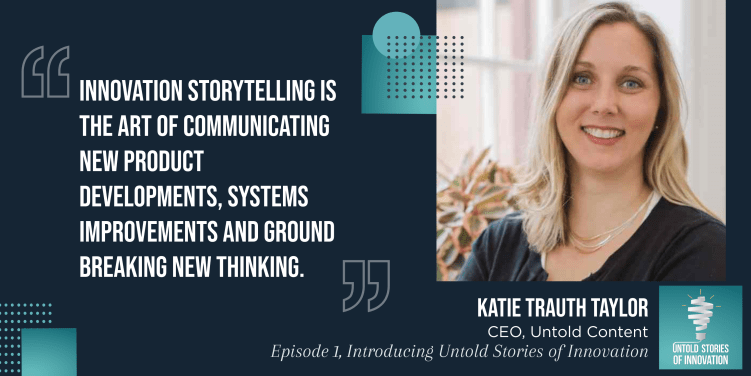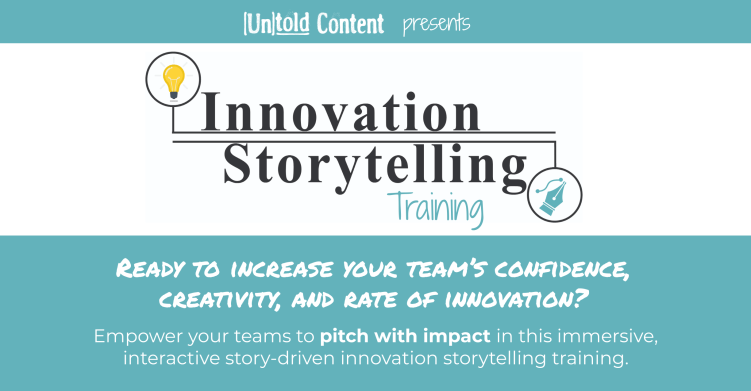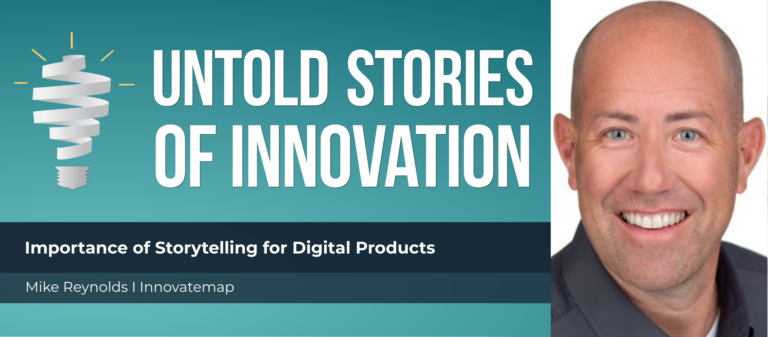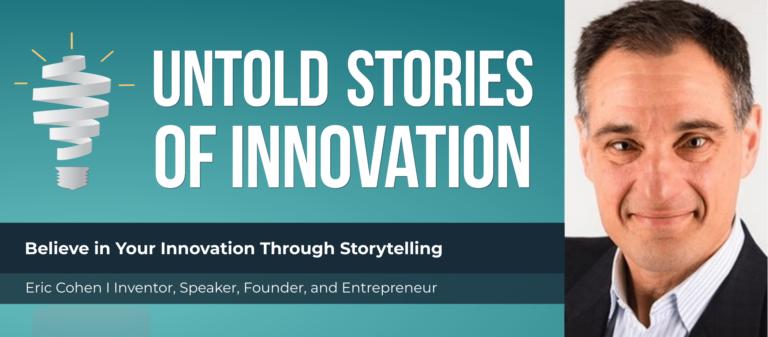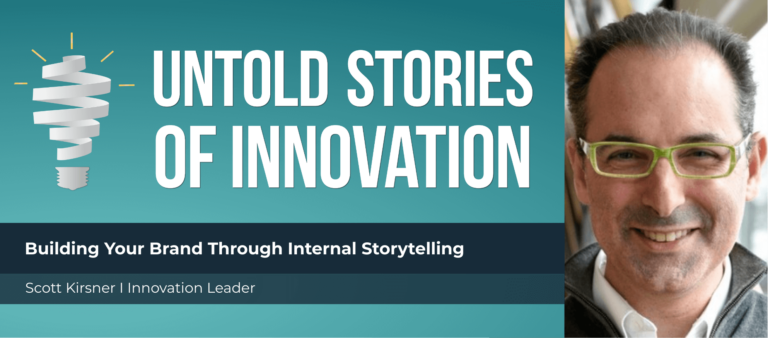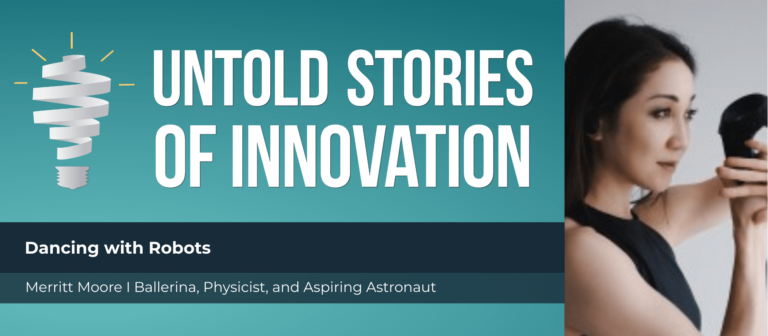Untold Stories of Innovation Introduction Podcast
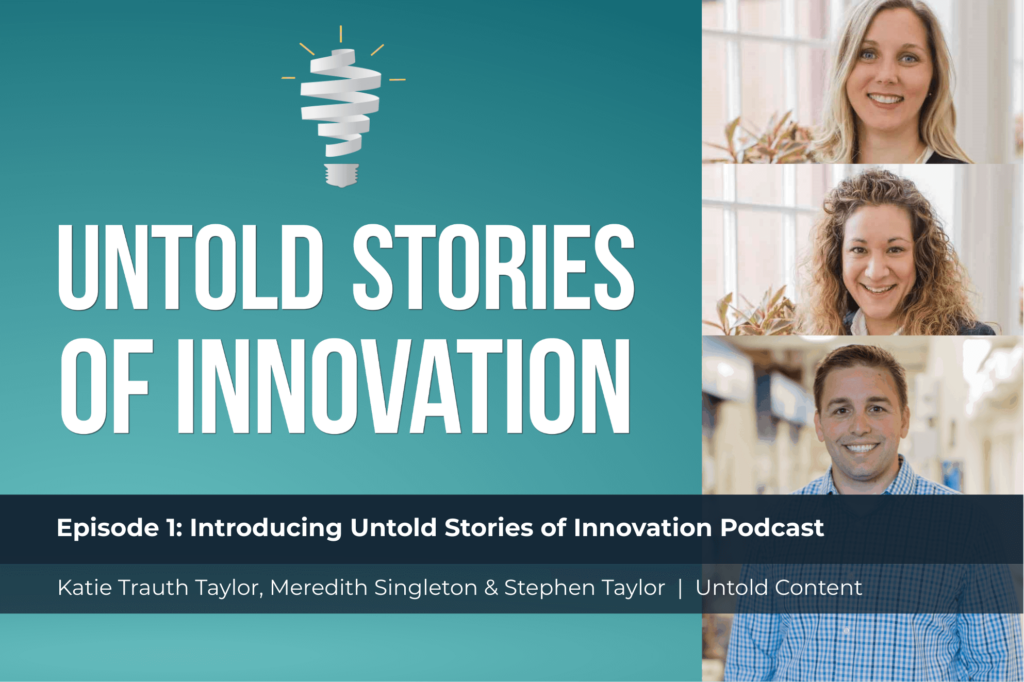
Introducing Untold Stories of Innovation - Untold Stories of Innovation
“Innovation storytelling is the art of communicating new product developments, systems improvements and groundbreaking new thinking.” —Katie Trauth Taylor, CEO of Untold Content
From today’s episode you’ll learn:
Why do stories matter to the innovation process? What values can be instilled in innovators who share stories? How do innovation leaders inspire creators to tell and share their success and failure stories?
Your host Katie Trauth Taylor, the CEO of Untold Content, invites her team members Stephen Taylor, COO, and Meredith Singleton, head of education and training, to answer these very questions. In helping subject matter experts and thought-leading organizations effectively communicate their big ideas, Untold Content has refined their expertise in crafting compelling innovation stories. Now, they’re ready to share their insights and amplify epic examples in the innovation community.

Kathryn (Katie) Trauth Taylor, PhD, is founder and CEO of Untold Content. Upon receiving her PhD in Rhetoric & Writing from Purdue University with an emphasis in Professional and Technical Writing, Dr. Taylor founded Untold as a writing consultancy devoted to empowering thought-leading organizations in communications and storytelling.

Meredith is a technical writer and instructional designer. She holds a PhD in Rhetoric and Composition from the University of Cincinnati. She has certifications in distance and online learning from the Online Learning Consortium and Quality Matters and is an expert in universal design and accessibility.

Equipped with a PhD in Chemistry, Stephen brings to Untold a decade of university research and teaching experience—plus another decade of industry R&D experience. With eyes for innovation and awards granted for scientific and technical presentations, Stephen supports companies in leveraging the insights of their experts.
This episode, Untold Stories of Innovation is powered by Untold Content’s innovation storytelling training. Increase buy in for your best ideas in this immersive and interactive, story-driven experience. Where your teams refine storytelling techniques for their latest projects, prototypes and pitches—and get inspired by 25 epic examples of impactful innovation stories. Learn more at untoldcontent.com/writing-training-for-busy-professionals.
Katie [00:00:00] Innovation storytelling is the art of communicating new product developments, systems improvements and groundbreaking new thinking. I have today on the podcast our team at Untold Content—at least three of us from our team, and we are the ones who created innovation storytelling workshops. We’ve delivered them to companies together. And I’m so grateful. Stephen Taylor, who is our chief operating officer, and Meredith Singleton, who is our head of education and training at Untold Content, are both here to talk with us today about innovation storytelling, why it matters and how we believe the innovation community can be empowered to communicate their ideas, concepts, prototypes and pitches effectively and compellingly and accurately. Thanks for being here on the podcast, guys.
Meredith [00:00:54] Thanks.
Stephen [00:00:54] Super excited to be here.
Katie [00:00:55] This podcast has been such a joy to create. We can’t believe the incredible people—the incredible innovation leaders and innovators—who are on this podcast. We have leaders from Disney, John Deere, NASA, Procter & Gamble, FM Global, Ecolab, Argonne National Lab, Polaris, PayPal. We have venture capitalists and investors as well as startup founders and entrepreneurs. Really, this giant range of stakeholders in the innovation community and this podcast is asking them to contemplate with us why storytelling matters, how to do it well, and how the future of innovation might be changed as a result of the stories we’re able to share and tell and how we can also transform cultures as a result of that. So why don’t we share—I already kind of provided a definition. This is the very first episode of the Untold Stories of Innovation podcast. Why are we doing this podcast?
Stephen [00:01:57] Well, the idea is that we want to share—we want to actually talk with innovators, people who are in the field, people who are actually out doing groundbreaking science, coming up with new insights, new ideas, and talk to them about how they go about getting buy-in. Because some of the real challenges are getting buy-in within an organization and actually getting engagement and feedback so that you have a meaningful path forward. And so the real idea here is that we want to talk to these people who are actually out doing the work. And what are the troubles that they face? And how have they actually overcome those challenges?
Katie [00:02:36] Yes. And from a training and education perspective, Meredith, why do you feel so powerfully about innovation storytelling and how innovators can be empowered to storytell and to communicate well?
Meredith [00:02:50] I think what we have learned over the years of working with innovators across different fields and industries is that they’re so passionate about the work that they’re doing. And we get that when we work with them on a one-on-one level. And we have the chance to really dive deeply into what they’re working on. But what we find across the board is that they’re struggling to make that same connection with people that they only have a few minutes with or one short meeting to make a big impact and to explain what they’re working on and why it’s so important to the company. And so they can do that when we work them through the process one-on-one or with our team and ask them the right questions. But when left on their own to sort through all the information that they know and to pull themselves away from the research they’ve been doing, they have a really difficult time doing that. And so what we have found is there is a way to do that. There is a process to work through what you know and to pull out the important pieces of information. And we’ve put together the workshop and the training to help them do that.
Katie [00:03:47] I love our backgrounds. We are such a diverse unit. The whole company Untold Content is diverse in terms of the talent pool that we draw from. And the typical persona of the people on our team is that they have graduate level degrees either in scientific and technical writing or in a scientific and technical discipline. And they’re highly published and powerful storytellers. Let’s just share our stories, I think. You know, just briefly, what brought you to Untold. Let’s say what our backgrounds are so that there’s some context on who we are.
Stephen [00:04:19] Yeah, absolutely. So my background is I’m a trained chemist. So, I spent—went through graduate school. I have a PhD in chemistry. So I spent five years in graduate school. And when I was graduating, after doing inorganic chemistry, I said, Man I want to try something different. So that thing that was different was actually going to Indiana to study marine biology.
Katie [00:04:40] At Purdue.
Stephen [00:04:41] At Purdue, of all things.
Katie [00:04:42] My marine biology in the middle of the cornfields.
Stephen [00:04:44] Right. Yeah, I mean, we were trying to figure out how oysters adhered to different substances or different structures in the water. So that was a fantastic experience, but it really caused you to stretch beyond your boundaries. And where you were comfortable. So when I got done with my postdoc, I decided to go to Shepherd Chemical and I was there for about seven years. I was a technical manager in their R&D group, and I said, you know, I really love the act of communicating around scientific information and issues and I want to do that more. And I want to lean into that—into building that skillset into others. So when the opportunity came to join Untold, I couldn’t pass it up.
Katie [00:05:27] Yeah. And what’s so interesting, Untold Content has supported and collaborated with Shepard Chemical in the past, and some of the storytelling work we’ve done in partnership with them has helped them win international innovation awards against major chemical players around the globe. And you in particular at Shepard were responsible for the creation of your new product development process, right? Your stage gate innovation process or you played a major role in its creation and its implementation.
Stephen [00:05:57] Absolutely. Yeah. We went through a process of trying to increase the number of new products that we’re actually producing. And so that caused us to say, how are we actually producing those materials? Let’s actually put in place a stage gate process so that we can help define what the funnel is for new product development and then be able to improve the efficiency and the effectiveness of actually getting new products all the way through that process. So, yeah, that was definitely a fun part of where I came from.
[00:06:29] So R&D is really where your roots lie. For myself, I studied technical writing and professional writing at Purdue for my PhD and afterwards went into academia as a research professor at a research one university and was teaching, you know, teaching all of those topics and at the same time started consulting with government, did a lot of, you know, sort of nationwide work on different campaigns and initiatives inside the U.S. Department of Veterans Affairs and built up this level of experience through that work. I was especially partnering with systems engineers and rethinking how we tell the story of health care systems design and why it matters to the patient experience. And at the time—this was during the V.A. Access crisis when far too many veterans were on wait lists to get in to see their doctors. And so the opportunity to really make an impact through stories, through words, being able to support the engineering teams and leadership inside the V.A. with communicating lean process improvement initiatives and many other kinds of methodologies that were being used to drastically transform, especially digitally transform, the patient experience inside the V.A. and got to really play an immersive role in that. Write a book with them about that and ultimately had to make a tough choice to either stay a professor or found this company. And I decided to resign and form Untold Content. And since then, we’ve just grown and grown over the last three years and worked with clients across the nation, especially in Silicon Valley, DC, New York and Cincinnati, which is where we are headquartered. And, you know, working across sectors, public sector, we continue to work in government. But a lot of the organizations that we focus on supporting our private sector, high growth startups or, you know, series funded startups all the way up to enterprise innovation teams in the science, tech, medical and social impact and social innovation sectors. And so that’s kind of my personal story. And Meredith, please share yours, too, because we have similar PhD backgrounds.
Meredith [00:08:38] Yeah. My road to coming to Untold is a little bit of a winding one. I have always had an interest in engineering and science. That’s where I sort of started my educational journey, but also really enjoyed writing always. And as I worked through graduate school and always had a full-time career in industry, working in different sectors. Writing has always sort of been at the core of what I was doing. So I never really imagined I would go the academic, full-time professor route. Started down that path and realized it was pulling me too far away from getting hands on and working with clients on the freelance and side portion of what I was doing. So serendipitously this position with Untold came at just the right time when I was trying to think about what’s the next step. I don’t want to be teaching in the classroom forever, but I do love teaching and training. So this opportunity came about to combine all of those: working with science and tech industry, doing the writing that I loved, and also tapping into the training and teaching background.
Katie [00:09:39] Yeah. So what’s really interesting about the two of us, Meredith, is we both have PhDs in the same degree. You know, professional writing. But my emphasis was really—my research was around public rhetorics and scientific and technical communication. And yours was around all those things, but also specifically instructional design. So tell us a little bit briefly about what that is and how that adds a different layer to, kind of, who we are and what we do.
Meredith [00:10:35] So instructional design is all about, how do you put the learner at the center? How do you build the content in a way that’s accessible to them, regardless of the expertise level of the content they’re working with and thinking about how do learners learn? There are different theories and strategies around that. So how do we apply that to content that they’re learning, whether online, in the classroom with an instructor or facilitator or on their own or in some kind of combination of those?
Katie [00:11:54] Yeah. And so when we started studying innovation storytelling, we’ve been doing innovation storytelling at Untold for years. It’s really the heart and soul of what we do in terms of—our clients tend to be research and development departments or organizations that are highly innovative in nature. And so much of what they need to do is be able to speed up their innovation process, get more product, more really high-quality new products out the door. And so the role that we play with our clients in that process is supporting them in internal storytelling. So getting buy-in for potential ideas and also helping them with storytelling and sharing through each stage gate of their innovation process to the point where either that that initiative is deemed not worthy of pursuing or it goes to market or scales. And then, at that point too, we’re oftentimes supporting the external story. So what do customers hear, what do users hear, how do we prepare? How do we support our clients in helping their customers prepare for the future? And that’s where innovation storytelling workshops and our, really, hyper focus on researching and understanding the role that storytelling plays in innovation was born. I just want us to, kind of, bring this all to life a little bit. Like let’s paint some pictures of what innovation storytelling looks and feels like, how it breathes and moves. So we’ve identified a lot of epic examples of innovation storytelling, and we dive deep into them during our workshops with clients. But let’s share some of our favorite epic examples to bring it all to life.

Stephen [00:13:44] So let’s jump to a situational example. So this is something that I experienced for much of my academic life, postdoc life, and a few times within industry. Going to conferences. You’re constantly put in a position where you’re either—you’re either presenting a poster and talking to a group of people that are coming by kind of continuously for several hours. You’re either giving a talk or you’re in an opportunity to actually give an elevator pitch. Those are all examples of innovation stories. But the thing that a lot of times people don’t take into consideration is that the audience that you’re talking to most of the time are either experts within your field or they know a lot about your field to be able to have those conversations. So the exchange there is really among peers—people that are of the same education level, people that can have that really in-depth conversation. The challenge becomes, when you step out of that peer group and you go to people that are semi-experts or not really experts in that area, you still need to give a very engaging conversation, getting even beyond the trying to explain it like you explain it to your parents, like how do you talk to someone who is outside your field, maybe an expert in a completely different field, and actually be able to get them to be engaged and really get that authenticity that you’re looking for so that they buy-in to your ideas.
Meredith [00:15:13] I love that. I have an example that I enjoy. One of the examples that we use in the workshop about disrupting the narrative, and this example came out of some research we were doing around white papers. And what does a white paper look like? I think that’s changed a bit over the course of the last few years of how people are using them as producing content. We came across this white paper on the Volocopter, which is basically—
Katie & Stephen [00:15:39] Volocopter!
Katie [00:15:39] You have to say it that way, too. Like one more time.
All [00:15:44] Volocopter!
Meredith [00:15:44] So the Volocopter. The whole concept is urban air taxis. So taking traffic off the ground, moving it to the air through one-person, two-person sized air helicopters. And when we first came across it, it was a great example. It’s a beautiful piece as a white paper example. But we started talking about it around the concept of this is such a disruptive idea of when we think about what kinds of innovation can happen around transportation. So how do you tell a story that on the surface sounds so ridiculous and so much would need to change in order for that to happen? How did this company write this white paper in a way that isn’t only engaging but starts a conversation about, is that really possible? Your first reaction is no and here are all the reasons why. But as we started reading it more and looking at their examples and listening to their story, the way they were using evidence, we started getting a little buy-in to that idea like, well, wait a minute, maybe this is possible. And we’re still talking about it. So what a great example of an idea that can seem so far off the wall that no one’s going to buy into it. But all you have to do is start the conversation. And that’s what they did. And they did it beautifully.
Stephen [00:16:55] Well, it kind of sets up the—so going back to the idea for Pixar +i. So if you set up the idea and even within a white paper, if you get people’s imaginations moving in a direction and questioning whether something can be real and starting to imagine about it, all of a sudden they start saying, well, “yes and” this and “yes and” that. So it’s—even if the concept is far away, if you leave it open-ended enough where people can actually insert, you know, how they see it becoming a possibility. Then, all the sudden, something that was far-fetched—you actually see a roadmap to actually achieving it.
Katie [00:17:33] Definitely. I love how you’re pointing out some of the innovation story patterns that we identified, you know, as part of building this workshop experience. And we essentially looked at innovation stories across sectors for internal purposes and external purposes. We looked at other research that had been conducted in adjacent industries and we pulled, I think it was, over a thousand stories and analyses. And we came to really a handful of core patterns that you see in innovation stories. And Meredith, you just mentioned disrupting the narrative. That’s a great Volocopter is a great example of disrupting the narrative and how to sort of help consumers or users envision a future and do so in a way that builds credibility and not fear or not, you know, doesn’t do that in a way that isolates, makes sure that it’s relatable.
Meredith [00:18:26] And not even in a way that—just talking to consumers. Often, you’re faced with that same pushback if you’re trying to pitch internally. What’s the fear? What are the challenges? What are the borders that keep us from doing that? And how do you have responses ready for those right away, lined up, ready to go, because you’re going to face those same kinds of pushbacks, whether it’s internal or external.
Katie [00:18:49] Absolutely. Yes. Especially when you’re—as an innovation team—you’re trying to collaborate with all of the other stakeholders internally who you really need to be your partners or you need to be your champions in order to get anything off the ground. I’m thinking of how critical it is to play well with marketing or sales or operations or consumer insights and really being able to speak each other’s language and pull together and have a shared—be able to make it relatable, even internally. So critical.
Stephen [00:19:19] The one narrative that we talked about a lot was the perspiring innovator, the one that has to keep going back to the bench and keep working. And there’s lots of examples of great innovations that came out of that process. So one of them is WD-40. So WD-40. The 40 is actually the number of iterations. It was the 40th iteration that actually became the final formulation of that product. But it was a long, tedious process. And so having the endurance to go back every time and keep innovating and keep improving each time, you know, that that takes a lot and puts a lot on the innovator. Another thing that it goes back to is that innovation is really about an ecosystem. So you’re—there really is no—the idea of the garage guru. When it comes to innovation within an organization, that’s not— that doesn’t happen.
Katie [00:20:19] Like the solo genius, just inventing something in isolation in their garage.
Stephen [00:20:23] Right.
Katie [00:20:23] Coming out with the world’s next thing. I mean, we’re not saying it doesn’t happen, but 99 percent of the innovation that’s occurring around the world does not happen like that. It happens in teams and it’s highly collaborative.
Stephen [00:20:36] Right. And so you have to come at it from a standpoint of empathy. That what I’m doing, the thing that I’m changing or this innovation that I’m working on, may have an impact on these other groups within my organization. So you really have to put them as your audience and you need them to be your customer and to buy into this thing that you’re selling. So if you don’t put them at the forefront of your story, then it’s never going to work, and you’re always going to get pushback.
Meredith [00:21:01] I think one of the beauties of our workshop is that we spend so much time with the teams in that position of think about who you’re talking to. Think about what motivates them. Think about what challenges they may have, what they’re thinking about on a daily basis. And if you don’t spend the time to do that up front, you end up spinning your wheels when you’re in front of them because you’re not giving them the exact kind of answers or evidence or motivation that they’re looking for to get them to say yes. And while I think on the surface, a lot of us think we do that, we don’t spend a good portion of time sitting and really getting deeply and thinking about that.
Katie [00:21:36] One observation we’ve made with innovation teams is that they tend to be really hyper aware of the end user, the end consumer, the customer. Thank goodness, right? That’s absolutely—always has to be—the customer’s needs always have to be at the heart and soul of why we innovate. Sometimes, though, the hyper focus on that can cause innovation teams to sort of forget how important it is to also be empathetic and align themselves with internal stakeholders, too, in order to assess feasibility and to get the right level of championing that’s needed to take a concept to the next phase in the stage gate.
Meredith [00:22:14] And working those ideas down into short pieces of information, short stories you can tell along the way. We’ve heard from innovation teams before that even small conversations you have in the elevator with someone in the right place or in passing when you’re in a different meeting and they’re asking what you’re working on. Being able to narrow down and really hone in on what you’re doing so that you can tell them really powerfully in just a few minutes or just a few seconds so that you plant the seed for future conversations later on. So you’re building that team of champions so that later when you go in front of the stakeholders and they say, OK, give us time to think about that. They start talking to other people who say, yeah, I heard about that. And it sounds like a really great idea. And then you’ve got already someone on your team cheering for you.
Katie [00:22:54] One of the hardest things about being an innovator, what we hear with our clients and the leaders and the product engineers that we’re talking with all the time, is carrying the torch for innovation. And being the change makers inside of an organization can be exhausting. It can be so—it can really get you down when your concepts keep getting shelved. It is so frustrating. And I think there’s a lot—you’ll hear, listeners to this podcast, you’re going to hear the voices of leaders from the most incredibly innovative organizations on the planet. And the commonality there is that the organizations embrace innovation at the enterprise level. Everyone is encouraged and trained to think creatively, to think it through curiosity, to be able to innovate even within their own line of work. And I don’t care if that person is doing the most rote task. If the organization is empowering that individual to be open minded, that makes the people who are, you know, wearing the hat, the innovation hat, wearing the title, wearing that responsibility to churn out new products and new approaches—it makes all of that happen so much more seamlessly and with so much more momentum. It’s just really challenging when innovation only occurs in a bubble inside of an organization.
Meredith [00:24:21] We had a great experience with a workshop that we offered where we had multiple people represented, multiple departments represented at the table through the workshop so that everyone could experience and learn about what the innovation team was working on at that moment and hearing deeply why they were so passionate about what they were doing. And that was a great opportunity to share across the organization in a way that I don’t think that they had done before, so that people in sales and people in marketing and people in areas that don’t necessarily work together on a daily basis had a chance to understand why what they were doing was so important, why the message resonated with them and not with others. It was a great experience. And I think that’s one of the beauties of sharing these kinds of stories that you’ll hear on the podcast is that you’ll get to hear about things that maybe you wouldn’t hear about that might actually be happening in your organization, too. And hopefully that will start conversation internally.
Katie [00:25:18] I love when a workshop is diverse like that. I mean, we provide this workshop certainly just to innovation teams or just to engineers or just to scientists. But something really interesting can happen in the workshops where they’re able to pull in insights and sales and operations and they all come together and they’re all still practicing innovation storytelling together. But we’re able to get to a level of empathy and alignment throughout the organization that’s more challenging to get to if we’re only just speaking to the innovation team. We’ve been talking a lot about empathy. Part of the structure around our workshop and part of the structure around this podcast is you’re going to hear me in these interviews with innovation leaders speak to five different drivers of innovation storytelling. That’s empathy, alignment, engagement, evidence and impact. And according to our analyses, according to our boots on the ground in the field, and according to this, you know, tons of interviews we’ve been conducting as part of this podcast, those are the drivers that we see as fueling innovation storytelling. And for an innovation story to be successful, it really needs to have all of those things. I want to start with evidence a little bit. And I’m looking at you, Stephen, which you can’t see me if you’re listening to this podcast. But tell us why evidence is so important to the scientist, to the clinician, to the data analyst, to the researcher, and tell us some of the challenges that tend to face us when we have to go and get buy-in and we are so in love with our evidence.
Stephen [00:27:02] Well, as a scientist, you’re always taught: put it all on the table. And that’s a lot of times because you’re talking to other experts. And so you’re going to take your lab notebook or you have your presentation. You’re going to have 70 slides and you’re going to say, here’s everything that I know. But what you need to do is think about who’s the audience that you’re actually talking to. And what do they need to know to get to the next step. And so we spent a lot of time talking about evidence. And part of the real struggle that I think people face is that at the beginning, it’s a story. You know, at the beginning, when you start a project, you concept the story or the thing—the problem that you’re trying to solve. And once you get buy-in that this is an important thing that you need to go solve, then every time after that you have to come back and add some pieces of evidence to show that you’re building toward something at the very end that is actually tangible. So if you don’t pair your story with your audience and incorporate evidence with it, then you’re actually going to lose a lot of credibility. So one thing that we talk about is looking at an evidence impact quotient. And so basically what that means is that you’re looking to have an impact on an audience. And so if you put this like on a bell curve and you say, OK, if I add too much evidence, then people are going to get lost, especially people that are non-experts. If I don’t give enough evidence, then people that are experts or even maybe non-experts are not going to be fully trustworthy. So there’s an ideal amount of evidence that goes for each audience in each type of story that you’re trying to create. So that’s something that we constantly go back and look at, is how much evidence do we need to convey the point that we need to convey in order to have the impact that we want to have?
Katie [00:28:50] One of my favorite moments from a workshop, an innovation storytelling workshop, we delivered last year was we start the day by having—this is a vulnerable thing to ask—but we have participants stand up and pitch to us a current project that they’re working on, a current prototype or concept. And then throughout the day we introduce the drivers, we introduce epic examples, and we coach them. They have a chance to refine their pitch. And by the end of the day, that pitch looks very, very different. And I think one of the commonalities is that they really hone the impact evidence quotient. That’s really a key—one key heuristic that we find is incredibly helpful in transforming that pitch and empowering them to say all the data that I started with in the morning that maybe isn’t what I need to share when it comes to trying to get leadership to buy into this idea or get operations to partner with me on it. Right. There are ways that I need to pivot, pare down, make it relatable, make sure I’m revealing enough impact and just enough evidence. Really, evidence can strip away impact so quickly. If you just start with a statistic and you don’t have any other persona story or any other sense of how this is going to impact the department, the organization, the consumer, different partners, shareholders. These are all—to have an awareness of that as an individual on an innovation team. We find that awareness of that makes such a huge difference in their ability to storytell well and get buy-in at a much faster rate.
Stephen [00:30:25] Absolutely. So you need to go back whenever you’re creating these stories and actually map it out. What is the story that I had to tell? And then what are the pieces of that story that are actually really important to this person or this group of people? Because until you actually map it out based on the audience, you’re really just putting a lot of charts on a screen. And sometimes they may not need to see charts or sometimes they really need to see single data points or they need to see large dashboards. You know, it really depends on what your audience is and you should always keep them at the heart.
Meredith [00:31:00] We think of death by PowerPoint as sort of a PowerPoint that is so heavy and so long that the audience—you lose the audience. But in this case, the death by PowerPoint can be to your idea—that if you have so much in there, that the audience cannot get past slide one or slide two, then your idea is killed. You’ve done it.
Katie [00:31:21] Yeah, it’s really the power of the appendix. I have that slide ready, have it hidden. And I think, slides aside, one of the other drivers, right, is engagement. So we really try to encourage creativity in what medium you should choose to tell your story. One of the individuals who you’ll hear from on this podcast is the former V.P. of Creativity and Innovation at the Walt Disney Company. And he tells a story in that episode, and you’ll hear it here in a few weeks, but he tells a story of the architectural firm that won the opportunity to build Disney Springs in downtown Orlando. They were not the firm that came with the best PowerPoint or the best holographic representation of what that space would look like. It was the firm that gathered a bunch of rocking chairs in a circle in the boardroom. And when the Disney stakeholders came in, there was an older gentleman sitting in one of those chairs rocking and he said, come in, sit down, let me tell you about a place called Disney Springs. And he had them close their eyes and he just story told about how it would look and feel to go through that environment. And that was it. They won. And they had spent so little on their pitch. And so thinking with engagement in mind, what are some of your favorite epic examples for engagement?
Meredith [00:32:47] One of my favorite examples of engagement isn’t necessarily one that we’ve pulled from industry, but in an actual workshop that we delivered. We spent the day with this team who had originally thought that delivering their pitch, their innovation pitch meant, how am I going to design the slide deck? What is the—how many slides is it going to be? What’s the template can I use? So we spent the day really breaking out. Who are you talking to? Who’s the persona? What motivates them? We built this great persona for them. We, in the workshops, get you out of your seats and start putting you in the position of having to try this and writing a script. What would that look like? And so the team spent the day doing that. Writing a script. And when we asked them to re pitch at the end of the day, their level of engagement meant we’re going to stand up here and do a short play, imagining we’re in the positions of the consumers that will be directly affected by this innovation we’re working on and speak directly to this is how this is going to change my life, this is what this means to me as a consumer. And they had totally lost the idea of this needs to be a pitch deck, but instead started thinking about we’re going to engage the audience by showing them this is what this might mean to the people in the end that we’re serving. Totally changed their thought process, their perspective of what it meant. That for me was a perfect example of how do you engage. Engage the teams and engage with the audience and engagement all across the board.
Katie: [00:34:12] That example was so powerful, especially because we got to see a few months later—they brought us on to not give another workshop but actually work hand-in-hand with them to produce what ultimately did end up, from a delivery standpoint, being a slide deck. But we incorporated persona storytelling inside the deck and those early seeds of how do we add the consumer’s voice to our pitch ultimately became a visual representation. We helped them with the design of that and the script writing for that and just honed it and made it cleaner. It was neat to see how a seed of something creative and playful in the workshop ended up transforming the primary way that they spread their message of innovation internally.
Meredith [00:34:59] And they started thinking about how are ways that we can gather and deliver the information and the research. So we’re going out, and we’re asking people who are testing this, well, what if we record them? What if we just take a short video of them while they’re telling us what they think? So they started thinking definitely about how to engage as well.
Katie [00:35:15] Yeah. And that comes into the front end of innovation as well in their ideation process—how they come up with ideas and seed ideas to one another or collect insights and transform them into prototypes.
Stephen: [00:35:26] So one of the other things about being a perspiring innovator or going through this whole process is that it’s not just the innovator that’s perspiring. Organizations themselves put out really lofty missions and goals. And so even to innovate or to constantly be pursuing these really far fetching ideas, you know, that is an act of a perspiring innovator—always trying to reach and improve to get to the next thing. So I’ll give you an example that really touches me. And you all have heard this story a ton. And it’s still such a great story because of the way that people describe failure narratives.
Katie [00:36:12] You hear us laughing because Stephen gets so excited about this story, and we kind of tease him about it. But it truly is a great innovation story.
Meredith [00:36:22] To Stephen’s credit, he has honed the pitch of this story in the amount of times we’ve asked him to explain it.
Katie [00:36:30] Each time we get a chance to deliver this workshop with innovation teams, we’re like, are we going to go for the Danone story or not? Tell us the Danone story.
Stephen [00:36:37] Yes. Thanks. Thanks, guys. I really appreciate it. So the Danone story is that they actually went about trying to develop a fortified yogurt to service developing countries in Africa. The challenge, though, was how do you distribute material, you know, within developing countries? And so that was a really big challenge that they had to face. Ultimately, within the case study, they were able to do it. And so it’s taught as being this failure. They developed the new technology, but it wasn’t successful in the long term. But when you look at Danone today and what Danone has developed, they have another adjacent organization called Danone Communities. And that organization actually is implementing, not necessarily the exact yogurt that was being produced, but they’re developing infrastructure within these developing countries that actually serve that very need. Perspiring innovators. It doesn’t always look like the first solution that you started with, but if you keep moving to that goal, that is still an act of perspiring innovation. So, yes, that particular one was not successful. But in the long term, because they keep their goal at the heart of what they’re doing, they’re going to be successful.
Katie [00:37:56] One thing we talk about a lot and one observation we’ve made in conducting the research involved with this podcast is how can storytelling be leveraged to create a culture of innovation? And so stories of success and stories of failure and figuring out how to share and tell and absorb those internal stories and get comfortable and vulnerable enough to say here was the success and let’s not just inflate our egos and just brag about it. Let’s figure out who were the individuals that made it possible, what were the circumstances and the market conditions that made it possible. Analyzing our successes in the same ways that we analyze our failures and being vulnerable enough to expose failures and take responsibility for it, too. From a leadership perspective, from a project team perspective, you know, it can be so terrifying to face a failure. And ultimately, those organizations that are willing to accept failure will be innovating faster and ultimately will be the ones who are more likely to disrupt, more likely to have a greater speed of new product development.
Meredith [00:39:11] And change the lens through which you look at what is success and failure. Success doesn’t always mean greenlight. Sometimes success means we understood earlier on this isn’t an innovation that’s going to work for us. It doesn’t align with what our future goals are. It doesn’t support what we’re doing right now. So we’re gonna shelf it for now and move onto the next one. That in itself was a success because you got a decision and you could move forward from that move onto the next one. So that doesn’t always mean failure. It just means we got the decision that we wanted, yes or no, and we’re ready to move to the next thing.
Stephen [00:39:37] Yeah. And just because a project doesn’t work doesn’t mean that it’s actually failed. It just means that you are completely aligned with your mission and your goals. You’re moving forward with good alignment.
Meredith [00:39:47] Sometimes what brings innovation teams down is they’re just turned away and they’re not sure why. If they can get a reason of this works, this doesn’t work, this supports it, this doesn’t. There’s a clear-cut reason and they’re not left in these limbo spaces of continuing to work on that, but we’re not sure what we’re doing with it. That in itself can bog down the creativity. But if they know we’re totally on board with this, it meets all the criteria that we have. Check, check, check. Let’s go. Or no, for these very specific reasons, then that gives them—sort of clears the desk to start over again.
Katie [00:40:20] And the beauty, I think, of what we’re trying to amplify as part of this effort around innovation storytelling is the idea that we should not, as innovators, leave anything on the table when it comes to being able to articulate the idea really well, get buy-in or get alignment if it’s not necessarily the right path to keep pursuing for that particular concept or idea. And the idea is let’s get more innovators to feel empowered to not fail because they didn’t tell the story as best as they could. Stephen and Meredith, obviously, I love working with you. It’s such a joy that we’ve made—not just the three of us, but everyone on the Untold Content team has pulled together to design and create this listening experience for people in the innovation community. And I’m so grateful that we have the chance to make this kind of impact together. Thanks for being here today.
Stephen [00:41:18] Oh, it’s been exciting. Thank you.
Meredith [00:41:19] Thank you. Super excited to get this going.
You can listen to more episodes of Untold Stories of Innovation Podcast.
*Interviews are not endorsements of individuals or businesses.
